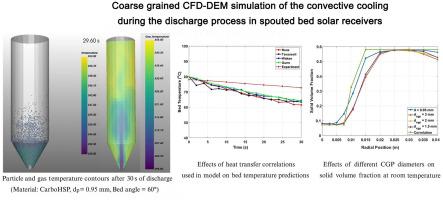Coarse grained CFD-DEM simulation of the convective cooling during the discharge process in spouted bed solar receivers
IF 4.3
2区 材料科学
Q2 ENGINEERING, CHEMICAL
引用次数: 0
Abstract
One of the emerging applications of spouted beds is their utilization as thermal energy storage units in concentrated solar power systems (CSP). Computational Fluid Dynamics-Discrete Element Method (CFD-DEM) is one of the approaches to model multiphase flow reactors and gain insights into their behavior. Although several studies have used the CFD-DEM approach to investigate heat transfer in fluidized and spouted beds, research on CFD-DEM thermal modeling of spouted beds specifically as solar receivers in CSP systems remains limited. Therefore, the aim of this study is to evaluate the predictive capability of the CFD-DEM approach for modeling spouted bed thermal receivers and to gain insight into the hydrodynamic and thermal parameters that influence simulation results. An open-source program MFIX (Multiphase Flow with Interphase Exchanges) was used for model development. For model validation both cold and hot laboratory scale (15 cm cylindrical diameter, 60° conical angle) conical spouted beds were built and used in experiments. CFD-DEM simulations were carried out for Carbo HSP particles (dp = 0.95 mm, ρp = 3630 kg/m3) at a static bed height of 100 mm. Throughout the study, the coarse-grained particle-DEM (CGP-DEM) method was used to reduce the computational time. The hydrodynamic simulation results indicate that gas-solid flow behavior in the spouted bed is well captured using both CGP-CFD-DEM and CFD-DEM approaches. The coarse-grained simulations of convective cooling during the discharge of a directly irradiated spouted bed with CarboHSP particles slightly underpredict the experimental cooling curve. Since the cooling curve is highly sensitive to wall boundary conditions, accurately determining these conditions is crucial for precise heat loss predictions. Furthermore, the coarse-grained particle diameter was found to have no significant effect on bed temperature.

喷淋床太阳能接收器放电过程对流冷却的粗粒度CFD-DEM模拟
喷涌床的新兴应用之一是将其用作聚光太阳能发电系统(CSP)中的储热单元。计算流体力学离散元法(CFD-DEM)是建立多相流反应器模型并深入了解其行为的方法之一。尽管一些研究已经使用CFD-DEM方法来研究流态化和喷淋床的传热,但针对CSP系统中作为太阳能接收器的喷淋床的CFD-DEM热建模研究仍然有限。因此,本研究的目的是评估CFD-DEM方法对喷射床热接收机建模的预测能力,并深入了解影响模拟结果的水动力和热参数。模型开发使用了一个开源程序MFIX (multi - phase Flow with Interphase Exchanges)。为了验证模型的有效性,建立了冷热实验规模(柱面直径15 cm,圆锥形角60°)的锥形喷淋床,并将其用于实验。在静态床层高度为100 mm的条件下,对Carbo HSP颗粒(dp = 0.95 mm, ρp = 3630 kg/m3)进行了CFD-DEM模拟。在整个研究过程中,为了减少计算时间,采用了粗粒度颗粒- dem (CGP-DEM)方法。流体力学模拟结果表明,CGP-CFD-DEM和CFD-DEM方法都能很好地捕捉喷淋床内的气固流动行为。采用粗粒度模拟方法对直接辐照喷淋床放电过程中的对流冷却进行了模拟,并对实验冷却曲线进行了预测。由于冷却曲线对壁面边界条件高度敏感,因此准确确定这些条件对于精确的热损失预测至关重要。粗粒颗粒直径对床层温度的影响不显著。
本文章由计算机程序翻译,如有差异,请以英文原文为准。
求助全文
约1分钟内获得全文
求助全文
来源期刊

Particuology
工程技术-材料科学:综合
CiteScore
6.70
自引率
2.90%
发文量
1730
审稿时长
32 days
期刊介绍:
The word ‘particuology’ was coined to parallel the discipline for the science and technology of particles.
Particuology is an interdisciplinary journal that publishes frontier research articles and critical reviews on the discovery, formulation and engineering of particulate materials, processes and systems. It especially welcomes contributions utilising advanced theoretical, modelling and measurement methods to enable the discovery and creation of new particulate materials, and the manufacturing of functional particulate-based products, such as sensors.
Papers are handled by Thematic Editors who oversee contributions from specific subject fields. These fields are classified into: Particle Synthesis and Modification; Particle Characterization and Measurement; Granular Systems and Bulk Solids Technology; Fluidization and Particle-Fluid Systems; Aerosols; and Applications of Particle Technology.
Key topics concerning the creation and processing of particulates include:
-Modelling and simulation of particle formation, collective behaviour of particles and systems for particle production over a broad spectrum of length scales
-Mining of experimental data for particle synthesis and surface properties to facilitate the creation of new materials and processes
-Particle design and preparation including controlled response and sensing functionalities in formation, delivery systems and biological systems, etc.
-Experimental and computational methods for visualization and analysis of particulate system.
These topics are broadly relevant to the production of materials, pharmaceuticals and food, and to the conversion of energy resources to fuels and protection of the environment.
 求助内容:
求助内容: 应助结果提醒方式:
应助结果提醒方式:


